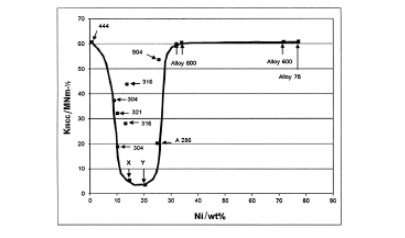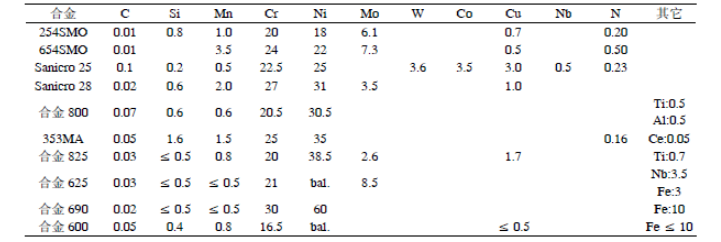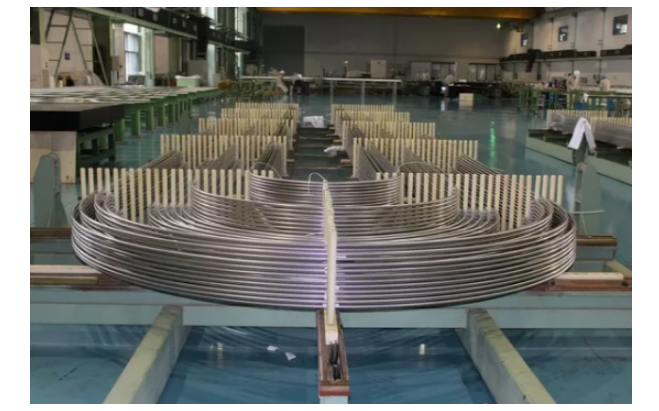Nickel_rich_austenitic_stainless_steel
Characteristics of nickel-rich austenitic stainless steel
What is the nickel-rich austenitic stainless steel? What are the characteristics?
The "Achilles heel" of austenitic stainless steel is prone to stress corrosion cracking (SCC). However, when the nickel content exceeds 20%, the stress corrosion resistance is greatly improved (Figure 1). Nickel-rich austenitic stainless steel (NiASS) can be considered as a separate type of stainless steel. In fact, when the nickel content exceeds 30%, the stress corrosion resistance is comparable to that of duplex and ferritic stainless steels.

figure 1
Figure 1 The Copson curve shows the effect of nickel on the stress corrosion threshold stress strength in iron-nickel-chromium alloys containing 16% to 21% chromium (105°C, 22% aqueous NaCl solution). X and Y are German superalloys, and 444 is an ultra-pure ferritic stainless steel. This figure is redrawn according to Speidel (1981).
Nickel is an expensive alloy element and is used only when necessary for performance. However, in some applications, when both stress corrosion resistance and austenitic structure are required, nickel is essential. For example, creep resistance is extremely important in high-temperature environments, where austenitic stainless steel is required. As with traditional austenitic stainless steels, because of their low stacking fault energy (see Figure 2), twin boundaries are a distinctive feature of nickel-rich austenitic stainless steels. Table 1 lists several limited nickel-rich austenitic stainless steel grades. Super austenitic stainless steels 254SMO and 654SMO are specially designed for the oil and gas industry. Typical applications are equipment such as seawater cooling, pulp bleaching, and hydraulic and instrument piping.
Table 1 Nickel-rich austenitic stainless steel alloy varieties


Figure 2 The microstructure of Sanicro 28 austenitic stainless steel under an optical microscope, which has a large number of twin boundaries
Sanicro 25, a 22Cr-25Ni alloy, is designed for boilers at 700°C and above. Because of its good creep rupture strength and high temperature corrosion resistance, it is a material suitable for super heaters and reheaters. In fact, Sanicro 25 has better creep rupture strength than most austenitic stainless steels in the range of 600~750℃. In highly corrosive and acidic environments, Sanicro 28 is usually the best choice. It is used in high-strength drilling with pipelines, casings, and acid gas well linings. Other applications include heaters, pump systems, and pumps and vessels in wet and super phosphoric acid plants.
Multi-purpose alloy 800 is commonly used in the environment of 550 ~ 1100 ℃, this kind of environment requires the material to have excellent creep resistance, good high temperature corrosion resistance and high temperature strength. This type of alloy is also used in the import and export of ammonia, methanol and civil gas, and alloy 800 is also a good choice for furnace tubes used in the production of vinyl chloride and ethylene. Other applications include heat exchange tubes, radiant tubes and heat treatment furnace components for fluidized combustion beds, such as muffler tubes and thermowells. The 25Cr-35Ni alloy 353MA is designed to be used in environments where there are potential problems with carburization and nitrogen absorption. It is suitable for cracking furnaces and reforming tubes that treat synthetic gases. Although there are other alternative materials containing more chromium, 353MA is optimal. One of the reasons is that it contains Ce element, which helps to form a very stable surface oxide layer.
Alloy 690, containing 60% nickel, is mainly used in the pipelines of steam generators in nuclear power plants (Figure 3). The operating temperature is 365°C. At this temperature, stress corrosion cracking between grains is a potential problem. Under the given service conditions, Alloy 690 is hardly corroded, so it is the alloy of choice.

Figure 3 Alloy 690 U-shaped tube ready for shipment and installation, used in nuclear power plant steam generator
Interestingly, we have noticed that nickel-rich austenitic stainless steel 254SMO is also used in art production. The sculpture "God, Father of All Living Beings, Above the Rainbow", designed by Carl Milles, was completed in 1995 on the south coast of Stockholm Strand (Figure 4). The sculpture is about 23m high. A large number of seamen pass by here every day. It is a famous attraction. The surrounding seawater contains salts and chlorides that can easily cause corrosion on the surface. If low-alloy steel is used to make the rainbow, it will rust almost instantly. The high-strength super austenitic stainless steel 254SMO provided by Avesta Sheffi eld AB is very suitable for this environment.

Figure 4
Figure 4 "God, Father of All Living Beings, Above the Rainbow" by Nak Strand, Stockholm Archipelago, designed by Swedish sculptor Carl Milles. This arched peace monument is a good example of the use of austenitic stainless steel 254SMO




